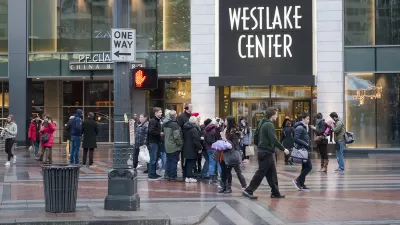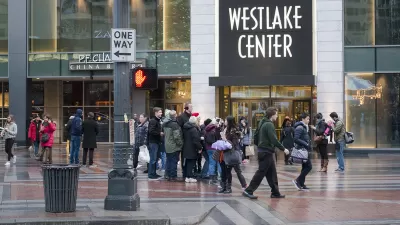With the plan update process for Seattle's Pedestrian Master Plan underway, one writer wonders why the plan is setting firmer goals for increased mode share.

Ryan Packer offers a critique of the Pedestrian Master Plan update currently underway at the Seattle Department of Transportation (SDOT). Noting that the number of commuters walking to work grew by 50 percent between 2010 and 2015, Packer determines that the plan update is disappointingly short on the kinds of goals that can further that progress.
For instance, Packer points out that the Pedestrian Master Plan lacks mention of the city's Vision Zero goal for 2035, and instead, "the goal is laid out as a decreasing rate of pedestrians involved in crashes."
Although Packer acknowledges the good intentions of the plan update, which includes mentions of pedestrian mode share, transit ridership, kids walking to school, and streetscapes, "without concrete goals to tell us just how successful our master plan is, we won’t be able to truly gauge success or failure."
Against this backdrop, Packer contrasts the Move Seattle levy, approved by voters in November 2015. That levy has a dashboard and a number of concrete targets to help residents track the success of that $930 million effort.
Back in August 2016, Packer also critiqued the implementation of the current version of the Pedestrian Master Plan, approved in 2009, focusing mostly on issue of maintenance and operations.
FULL STORY: Seattle’s Pedestrian Master Plan Is Short On Concrete Goals

Alabama: Trump Terminates Settlements for Black Communities Harmed By Raw Sewage
Trump deemed the landmark civil rights agreement “illegal DEI and environmental justice policy.”

Study: Maui’s Plan to Convert Vacation Rentals to Long-Term Housing Could Cause Nearly $1 Billion Economic Loss
The plan would reduce visitor accommodation by 25% resulting in 1,900 jobs lost.

Planetizen Federal Action Tracker
A weekly monitor of how Trump’s orders and actions are impacting planners and planning in America.

Wind Energy on the Rise Despite Federal Policy Reversal
The Trump administration is revoking federal support for renewable energy, but demand for new projects continues unabated.

Passengers Flock to Caltrain After Electrification
The new electric trains are running faster and more reliably, leading to strong ridership growth on the Bay Area rail system.

Texas Churches Rally Behind ‘Yes in God’s Back Yard’ Legislation
Religious leaders want the state to reduce zoning regulations to streamline leasing church-owned land to housing developers.
Urban Design for Planners 1: Software Tools
This six-course series explores essential urban design concepts using open source software and equips planners with the tools they need to participate fully in the urban design process.
Planning for Universal Design
Learn the tools for implementing Universal Design in planning regulations.
Caltrans
Smith Gee Studio
Institute for Housing and Urban Development Studies (IHS)
City of Grandview
Harvard GSD Executive Education
Toledo-Lucas County Plan Commissions
Salt Lake City
NYU Wagner Graduate School of Public Service




























